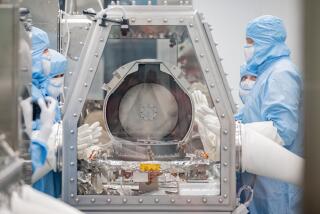It’s up, up and away for ancient trapped helium at Yellowstone
Talk about passing gas: Vast stores of helium are escaping from the steam vents and hot springs of Yellowstone National Park after being trapped within Earth’s crust for up to 2 billion years, according to new research.
In a study published Wednesday in the journal Nature, researchers with the U.S. Geological Survey determined that the famed national park was releasing hundreds -- if not thousands -- of times more helium than anticipated.
In fact, researchers say, the escaping helium -- about 60 tons per year -- is enough to fill one Goodyear blimp every week.
They also calculate that this “sudden” release of gas began roughly 2 million years ago, with the advent of volcanic activity there.
“That might seem like a really, really long time to people, but in the geologic time scale, the volcanism is a recent phenomenon,” said study coauthor Bill Evans, a research chemist at the USGS office in Menlo Park, Calif.
Helium, or more accurately the isotope helium-4, is produced in Earth’s crust as uranium and thorium decay. Often, this nonradioactive, crustal helium is swept away by groundwater, or freed as a result of tectonic movement.
But in areas where there is little groundwater or movement in Earth’s crust, helium-4 can remain trapped and build up over time. This is especially true at Yellowstone, where inactive rocks, or what geologists call “craton,” have been estimated to be 2.5 billion years old. (The park is located primarily in Wyoming.)
“The Yellowstone crust is among the oldest on Earth, and for most of its history had been part of the tectonically moribund core of North America,” said lead study author Jacob Lowenstern, a research geologist and scientist-in-charge of the Yellowstone Volcano Observatory.
Things began to change roughly 2 million years ago, however, when hot magma intruded on the crustal system from below and triggered several enormous volcanic eruptions, the most recent about 640,000 years ago.
“Think of it this way: You have these old crustal rocks just sitting around for hundreds of millions, perhaps billions of years,” Evans said. “They have this boring little existence, and then suddenly somebody puts the heat on under them and they start giving up all their long-held secrets.”
Yellowstone’s so-called magma “hot spot” still exists, and gives rise to the park’s numerous and crowd-pleasing geysers, hot springs and fumaroles.
The researchers said the discovery of high levels of helium was a result of their investigations into volcanic activity at the park, and came as a surprise.
Though the helium itself cannot be dated to determine how long it has been in the ground, they can extrapolate how long it’s been there by comparing density levels with other areas.
“This really isn’t a volcano story,” Lowenstern said. “But it reveals how the Earth’s crust behaves on a long time frame. The crust ‘holds its breath’ for long periods of time, and then releases it during tectonically and volcanically active bursts.”
In addition to inflating balloons and blimps, helium is used in electronics, the car and aerospace industries and healthcare. Though there is a current shortage of the element, the researchers said it was unlikely that Yellowstone’s helium would be captured and processed.
“It’s a national park, so you’d never set up an extraction industry there,” Evans said. “But even if that weren’t the case, it would still be difficult to capture this helium and purify it. It just wouldn’t be economical.”







